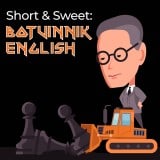We have a special treat for you today as we proudly unveil a guest post by International Master Richard Palliser on the subject of The Iron English – Updated!
This is the Chessable course on the English Opening (1.c4) which Richard co-authored with Grandmaster Simon Williams. The course was shortlisted for the prestigious Chessable Course of the Year Award for 2020.
Richard somehow found the time from editing CHESS Magazine to examine recent games from two key lines of The Iron English to provide our blog a world-exclusive update the highly-rated Chessable course.
We shall return to examine the course in greater detail in another post, but now it is time to enjoy Richard’s excellent annotations as he presents: The Iron English – Updated!
The Iron English – Updated!
Aleksey Goganov – Goganov Chigaev
Russian Championship, Moscow
2020.12.15
1.c4 g6
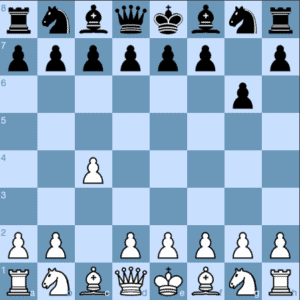
As users of The Iron English (‘TIE’) will be fully aware, there are a number of move orders which lead to some key tabiyas. For instance, here 1…e5 2.Nc3 Nc6 3.g3 g6 4.Bg2 Bg7 5.e4 would but be another route into the game.
2.g3 Bg7 3.Bg2 e5 4.Nc3 Nc6 5.e4 d6 6.Nge2 Nh6!?
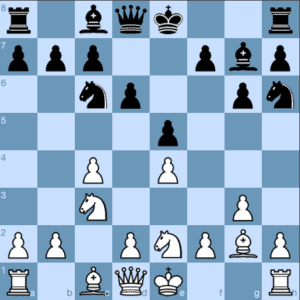
A fairly rare sideline, if one which has gained a bit of recent interest.
Simon’s Provocative Play
Black’s most common move is 6…Nge7, as faced by Simon Williams no less in only of the Titled Tuesday tournaments: 7.d3 0–0 8.0–0 f5 9.Nd5 Be6 10.Be3 (Unsurprisingly Simon knows just what to do – calmly complete development having occupied d5.) 10…Qd7 11.Qd2 Rf7 12.f3!? (A pretty thematic approach, although 12.Rac1 is actually our recommended move order in Line 2A of TIE.) 12…Raf8 13.b4!? (Typically Simon just can’t help being provocative and why not here? An exchange sacrifice is brewing…) 13…f4?! (Black can’t resist, but now we get to see the point of Simon’s play. Instead, 13…Nd4 would have left everything to play for.) 14.gxf4! exf4 and now in Williams-Golubev, Internet (Blitz) 2020, 15.Ndxf4! Bxa1 16.Rxa1 would have left White with excellent central control and compensation for the exchange, partly because 16…Ne5?! can now be well met by 17.Nd4 .
7.d3 f5
7…0–0 is a safer choice for Black, as we remarked in TIE. There, needless to say, we couldn’t resist pushing Harry: 8.h4 Nd4 9.f3 c6. This critical position received a recent (well, October 2020) test – and in an OTB game! 10.Be3 (10.h5 g5 11.g4!? was suggested in TIE, where we unsurprisingly slightly bailed out with an assessment of unclear.) 10…Qb6 11.0–0 f5 12.Qd2 f4! 13.gxf4 exf4 14.Bxd4? (14.Nxf4 Rxf4 15.Na4! Qd8 16.Bxf4 Qxh4 would have left Black with enough for the exchange, but no more than that.) 14…Bxd4+ 15.Nxd4 Qxd4+ 16.Qf2 Qxd3 and White was in trouble in Irizanin – M.Radovanovic, Serbian Team Championship, Bajina Basta 2020.
8.Nd5
Hardly terrible, but we preferred the immediate 8.h4! in TIE, when we simply couldn’t see a great move for Black – see Line 2B. One point is 8…0–0?! 9.Bg5 Qd7 10.h5 with serious pressure.
8…0–0
Here it Comes…

9.h4!?
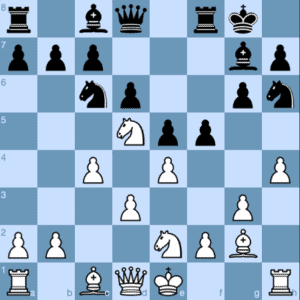
Even here advancing so must be critical, although Black is now able to get out of the way of Harry while preparing to meet h5 with …g5.
9…Nf7 10.Be3?!
Very natural, but probably not best. 10.h5 g5 was presumably a line which didn’t appeal to Goganov, although absolutely anything might have happened after 11.f4!? (11.exf5 Bxf5 12.Ne3 would be a more sensible approach, taking some control of the light squares) 11…gxf4 12.gxf4. There was also a more modest development of the bishop: 10.Bd2!? Nd4. Here 11.h5 g5 12.h6! Bh8! would just be extremely unclear, (Black taking care to avoid 12…Nxh6? 13.Nxd4 exd4 14.Qh5 f4 15.gxf4; and 12…Bxh6?! 13.Nxd4 exd4 14.Rxh6! Nxh6 15.Qh5 Nf7 16.0–0–0 with a huge attack for the exchange).
Unstable Knight
10…Nd4!
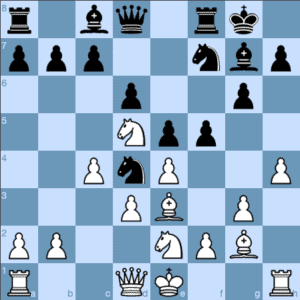
Suddenly White’s once-proud knight isn’t looking so great on d5 with …c6 on its way. Remember that Nd5 works especially well when Black has a knight on c6 and a bishop on e6.
11.Qd2
White’s set-up bristles with intent, but unfortunately Black is about to seize the central initiative.
11…Nxe2
11…c6 12.Ndc3 h5!? would have been a calm way to avoid any trouble on the kingside.
12.Qxe2 c6
Or just 12…f4 when 13.Bd2 (13.gxf4?! c6 14.Nc3 exf4 15.Bxf4 Ne5 would leave Black with …Bg4 on the way and excellent compensation for the pawn) 13…c6 14.Nc3 transposes to the game.
13.Nc3 f4!
Accept or Decline?
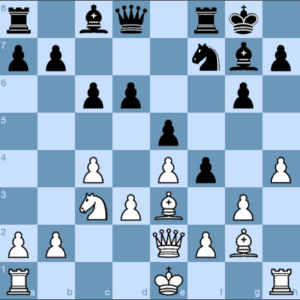
14.Bd2!
Goganov refuses to be seduced by the pawn on offer and instead keeps things tight at the back.
14…Nh6
14…Qf6!? 15.0–0–0 Nd8 is a clever manoeuvre pointed out by the silicon beast, leaving Black with control and a definite edge
15.f3!?
Threatening g4. White is quite happy to give up a pawn to open lines and obtain some play.
15…fxg3 16.Bg5?!
16.0–0–0! was the way to go. Yes, Black does have a little tactic available, but not one to overly fear: 16…Ng4!? 17.fxg4 Rf2 18.Qe3 Rxg2 19.Qf3 Rf2 20.Qxg3 Qf6 and here White’s simplest approach would be 21.g5 Qf7 22.Qg1 followed by Rf1.
16…Qe8
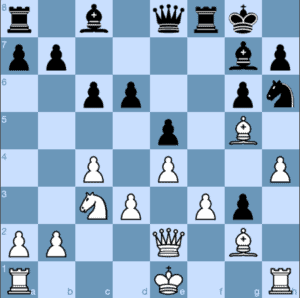
17.Be3!
Unlike certain politicians, Goganov recognises his mistake, so backtracks.
Rather than admitting the slip on the previous move, he might have ploughed ahead, but 17.0–0–0?! Ng4! 18.fxg4 Rf2 19.Qe3 Rxg2 20.Qf3 Rf2 21.Qxg3 Qf8 would now have left Black set to invade with his queen via the f3–square.
17…Nf7 18.0–0–0!
Not a move that you get to make too often in the Botvinnik English, but quite in tune with the position here. Which king is going to feel the heat first?
18…Nd8!
Chigaev continues to counter well, re-routing his knight to eye White’s holes on d4 and f4.
19.Qe1 Ne6 20.Qxg3 Nf4
Unstereotypical Thinking
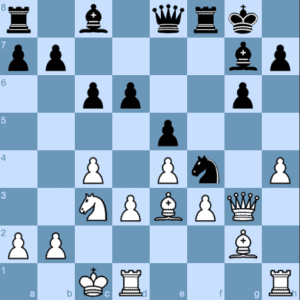
21.Bxf4!
An unstereotyped exchange, but a good one in this slightly worse position. It does leave Black with an unopposed dark-squared bishop, but how else to obtain any play as White, and with Black set to go …Be6 and …b5?
21…exf4
21…Rxf4?! 22.Ne2 would have left White with decent chances of getting somewhere on the kingside, such as with 22…Rf8 23.h5! gxh5 24.Bh3! forcing a positionally desirable exchange of bishops, to deprive Black of the bishop-pair and leave his king looking a little vulnerable, not to mention f5 as a fine outpost for the white knight.
22.Qf2 h5!?
Keeping lines closed, but this was no easy decision as now White will be able to target g6.
23.d4!?
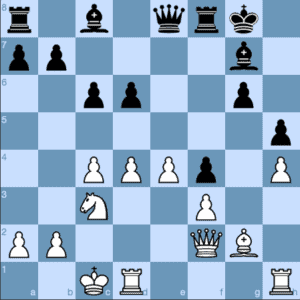
Setting up a big centre and blunting the unopposed dark-squared bishop. The alternative plan was still possible too: 23.Bh3 Bxh3 24.Rxh3. However, here White would have had to take care had Black reacted straight away in the centre: 24…d5! 25.cxd5? cxd5 26.Nxd5?? Qc8+ Whoops! Try to never forget John Nunn’s handy mnemonic LPDO (‘loose pieces drop off’).
23…Be6 24.Bf1!
Not so much defending c4 as bringing the bishop round into the attack.
24…a6 25.Rg1 Bf7
Even here Chigaev may have been feeling quite confident, with the bishop-pair and a queenside attack brewing, but he was not to be the first player to rather collapse when everything was now thrown at him.
26.Bd3 b5 27.e5!
Central Thrust
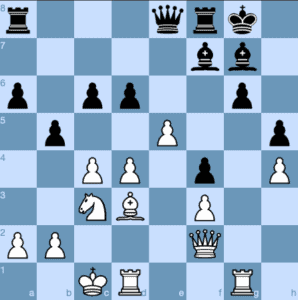
Here comes the kitchen sink…
27…dxe5
27…bxc4 28.Be4 was one of White’s points, but Black should be able to hold the balance: 28…dxe5 (28…d5? 29.Bc2 would be excellent for White with both Qg2 and Na4 high on the agenda) 29.d5 cxd5 30.Rxd5!? Rd8. White can pick up g6, but doesn’t seem to have any advantage: 31.Bxg6 Bxg6 32.Rxd8 Qxd8 33.Rxg6 Qd4 34.Qxd4 exd4 35.Ne4 leaves White with enough activity for his pawn (Rxa6 and Rc6 are threatened), but the game would surely have fizzled out to a draw.
28.d5
I wouldn’t be surprised if Goganov didn’t consider anything else, but there was also a direct approach: 28.Qg2!? exd4 29.Bxg6. White threatens Bh7+ and can get away with a temporary piece sacrifice: 29…Bxg6 30.Ne4 Ra7 31.Qxg6 Qxg6 32.Rxg6 bxc4 33.Rdg1 Rff7 34.R1g5. This does leave him two pawns down, but extremely actively placed and the engines rather like White’s chances.
28…cxd5 29.Nxd5?
29.cxd5 Rd8 30.Qb6! was the way to maintain a rough balance.
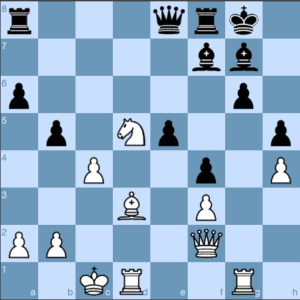
29…e4?
Thematic, especially in time-trouble, but it asks far too much of Black’s position here. 29…Rc8! would, however, have left Black for choice.
30.Bxe4 bxc4?
Complete collapse.
The Beginning of the End
31.Bxg6!
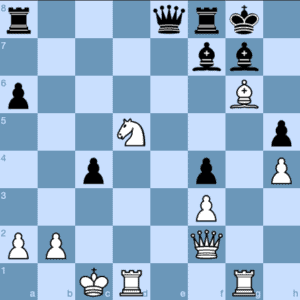
Even stronger than the fork on c7.
31…Rb8
31…Bxg6 32.Rxg6 would have been a massacre in view of a standard tactic: 32…Qxg6?? 33.Ne7+.
32.Be4 Bxd5
32…Qe5!? 33.Rxg7+! Kxg7 34.Rg1+ Kh6 (or 34…Kh8 35.Rg5) 35.Rg5 Qh8 36.Qg2 is also a game-ender in view of the threat of Rg6+.
Sacrificial Finish
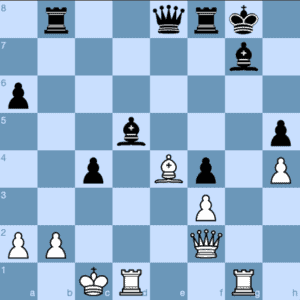
33.Rxg7+! Kxg7 34.Qg1+!
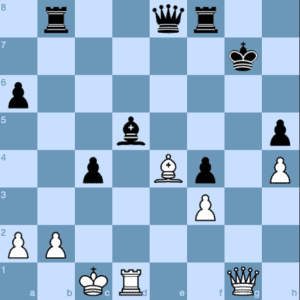
Fine geometry and Black gave up in view of 34.Qg1+ Kh8 (or 34…Kf7 35.Bxd5+ Ke7 when the fastest way to mate is apparently the impressively calm 36.Bxc4) 35.Qd4+ Kg8 36.Rg1+ Kf7 37.Rg7+ Ke6 38.Bxd5+ Kd6 39.Bf7+.
1–0
The Iron English: The Reversed Dragon
Richard now turns his attention to a recent game in another very popular line of the English Opening to conclude this piece on The Iron English – Updated!
1.c4 e5
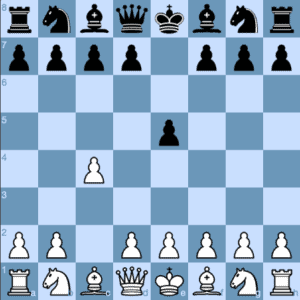
A closely-related set-up for White is our approach against the Rubinstein variation: 1…c5 2.Nc3 Nf6 3.g3 d5 4.cxd5 Nxd5 5.Bg2 Nc7 6.e3!? Here too White will go Nge2, 0–0 and then expand with d4 or f4.
2.Nc3 Nf6 3.g3 d5
3…Bb4 4.e4!? is or was a pet line of Carlsen’s. Top-level interest seems to have quietened down here for now, but don’t be surprised if this line pops up again this year.
4.cxd5 Nxd5 5.Bg2 Nb6 6.e3!?
Flexible and Dynamic
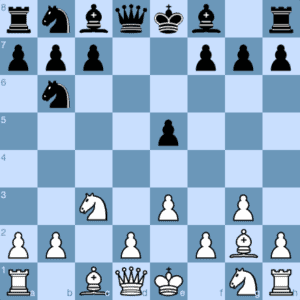
Our repertoire approach in TIE. White refuses to blunt his fine fianchettoed bishop and heads for quite a dynamic set-up with the king’s knight on e2.
6…Be7 7.Nge2 0–0 8.0–0 c6
8…Nc6 is a more common set-up, but also one which allows White to reveal his main idea (and pawn break): 9.f4! We covered a number of moves here for Black, but not a tempo loss seen in a recent game: 9…Bd6?! 10.d4 (10.b3; and 10.f5 both make good sense, with a decent case also able to be made for 10.Ne4!?) 10…exd4 11.Nxd4 Nxd4 12.Qxd4 Qe7?! 13.Ne4!. This left the Latvian WGM and politician acquiring the bishop-pair, while enjoying a mobile kingside majority in Reizniece – E.Atalik, European Online Women’s Club Cup (Rapid) 2020.
Seizing Central Control
9.f4!
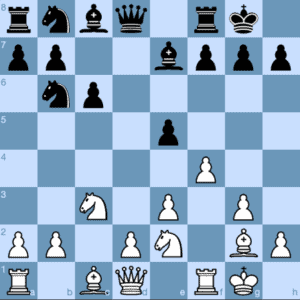
Breaking without delay and just watch how quickly White now gets to dominate the centre.
9…N8d7 10.fxe5
Direct and far from bad. However, in Line 4C of TIE we preferred another highly thematic idea: 10.b3!, keeping Bb2 and even f5 ideas in reserve.
10…Nxe5 11.d4 Ng6 12.e4 c5 Suddenly the position resembles a Grünfeld, but with a black knight, not pawn, on g6.
13.d5 f5? 13…Nc4 was the way to blockade.
14.Nf4
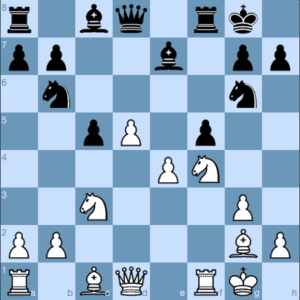
This left White with the safer king and seizing the initiative in Maghsoodloo – Praggnanandhaa, Internet (Blitz) 2020.
English Opening: Chessable Courses
We hope you enjoyed The Iron English – Updated! For further information on The Iron English, head for the two courses on the subject by Grandmaster Simon Williams and International Master Richard Palliser.
Short & Sweet: Botvinnik English
The Iron English: Botvinnik Variation
Readers may like to know there is a companion book, The Iron English, available from Everyman Chess and by the same authors.
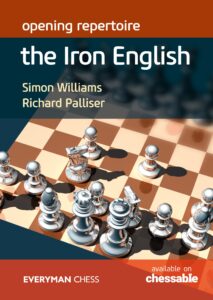
If you ever wanted to add 1 c4 to your arsenal of White openings then now is a good time to do so. The material is all there, just waiting to be used!



